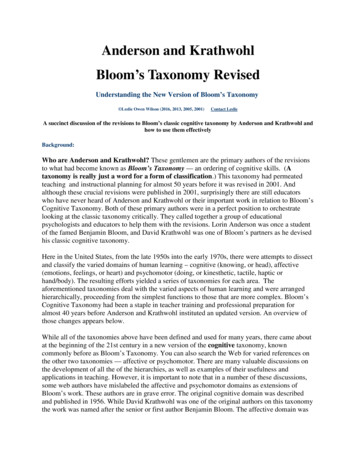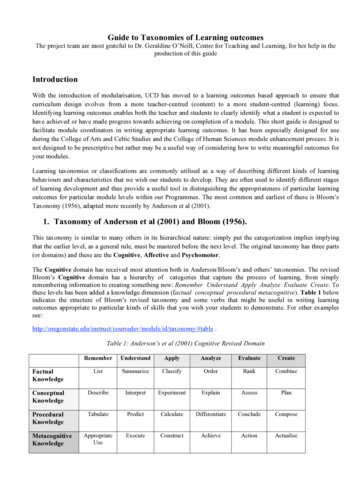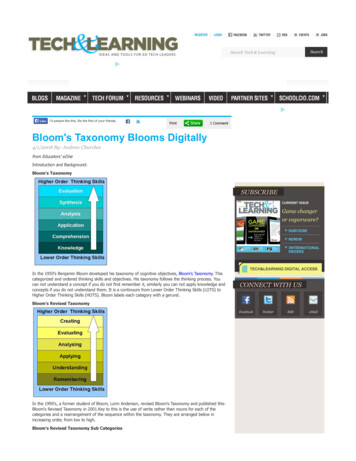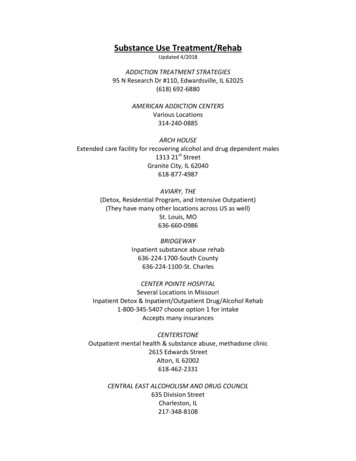
Transcription
Anderson and KrathwohlBloom’s Taxonomy RevisedUnderstanding the New Version of Bloom’s Taxonomy Leslie Owen Wilson (2016, 2013, 2005, 2001)Contact LeslieA succinct discussion of the revisions to Bloom’s classic cognitive taxonomy by Anderson and Krathwohl andhow to use them effectivelyBackground:Who are Anderson and Krathwohl? These gentlemen are the primary authors of the revisionsto what had become known as Bloom’s Taxonomy — an ordering of cognitive skills. (Ataxonomy is really just a word for a form of classification.) This taxonomy had permeatedteaching and instructional planning for almost 50 years before it was revised in 2001. Andalthough these crucial revisions were published in 2001, surprisingly there are still educatorswho have never heard of Anderson and Krathwohl or their important work in relation to Bloom’sCognitive Taxonomy. Both of these primary authors were in a perfect position to orchestratelooking at the classic taxonomy critically. They called together a group of educationalpsychologists and educators to help them with the revisions. Lorin Anderson was once a studentof the famed Benjamin Bloom, and David Krathwohl was one of Bloom’s partners as he devisedhis classic cognitive taxonomy.Here in the United States, from the late 1950s into the early 1970s, there were attempts to dissectand classify the varied domains of human learning – cognitive (knowing, or head), affective(emotions, feelings, or heart) and psychomotor (doing, or kinesthetic, tactile, haptic orhand/body). The resulting efforts yielded a series of taxonomies for each area. Theaforementioned taxonomies deal with the varied aspects of human learning and were arrangedhierarchically, proceeding from the simplest functions to those that are more complex. Bloom’sCognitive Taxonomy had been a staple in teacher training and professional preparation foralmost 40 years before Anderson and Krathwohl instituted an updated version. An overview ofthose changes appears below.While all of the taxonomies above have been defined and used for many years, there came aboutat the beginning of the 21st century in a new version of the cognitive taxonomy, knowncommonly before as Bloom’s Taxonomy. You can also search the Web for varied references onthe other two taxonomies — affective or psychomotor. There are many valuable discussions onthe development of all the of the hierarchies, as well as examples of their usefulness andapplications in teaching. However, it is important to note that in a number of these discussions,some web authors have mislabeled the affective and psychomotor domains as extensions ofBloom’s work. These authors are in grave error. The original cognitive domain was describedand published in 1956. While David Krathwohl was one of the original authors on this taxonomythe work was named after the senior or first author Benjamin Bloom. The affective domain was
not categorized until 1964 and as David Krathwohl was the lead author on this endeavor, itshould bear his name, not Bloom’s. Bloom had nothing to do with the psychomotor domain andit was not described or named until the first part of the 1970s. There are 3 versions of thistaxonomy by 3 different authors — Harrow (1972); Simpson (1972); and Dave (1970) See fullcitations below.The Cognitive Domain:The following chart includes the two primary existing taxonomies of cognition. Please note inthe table below, the one on the left, entitled Bloom’s, is based on the original work of BenjaminBloom and others as they attempted in 1956 to define the functions of thought, coming to know,or cognition. This taxonomy is almost 60 years old. The taxonomy on the right is the more recentadaptation and is the redefined work of Bloom in 2000-01. That one is labeled Anderson andKrathwohl. The group redefining Bloom’s original concepts, worked from 1995-2000. Asindicated above, this group was assembled by Lorin Anderson and David Krathwohl andincluded people with expertise in the areas of cognitive psychology, curriculum and instruction,and educational testing, measurement, and assessment. The new adaptation also took intoconsideration many of Bloom’s own concerns and criticisms of his original taxonomy.As you will see the primary differences are not in the listings or rewordings from nouns to verbs,or in the renaming of some of the components, or even in the re-positioning of the last twocategories. The major differences lie in the more useful and comprehensive additions of how thetaxonomy intersects and acts upon different types and levels of knowledge — factual,conceptual, procedural and metacognitive. This melding can be charted to see how one isteaching at both knowledge and cognitive process levels. Please remember the chart goes fromsimple to more complex and challenging types of thinking.Taxonomies of the Cognitive DomainBloom’s Taxonomy 19561. Knowledge: Remembering or retrieving previouslylearned material. Examples of verbs that relate to thisfunction are:know identifydefine recallrecord namerelate listmemorize repeat recognize acquireAnderson and Krathwohl’sTaxonomy 20011. Remembering:Recognizing or recalling knowledge from memory. Remembering iswhen memory is used to produceor retrieve definitions, facts, orlists, or to recite previouslylearned information.2. Understanding:2. Comprehension: The ability to grasp or constructmeaning from material. Examples of verbs that relate tothis function are:Constructing meaning fromrestate locate report identify discussillustrate interpret different types of functions berecognize explain describe discussdraw representthey written or graphic messagesexpressreview inferdifferentiateor activities like interpreting,concludeexemplifying, classifying,
summarizing, inferring,comparing, or explaining.3. Application: The ability to use learned material, or to 3. Applying:implement material in new and concrete situations.Examples of verbs that relate to this function are:Carrying out or using aapply relateorganize employpractice calculate procedure through executing, ordevelop translate restructure interpret show exhibitimplementing. Applying relates touse operatedemonstrate illustrate dramatizeor refers to situations wherelearned material is used throughproducts like models,presentations, interviews orsimulations.4. Analysis: The ability to break down or distinguish4. Analyzing:the parts of material into its components so that itsorganizational structure may be betterBreaking materials or conceptsunderstood. Examples of verbs that relate to thisinto parts, determining how thefunction are:parts relate to one another or howanalyze comparedifferentiate contrast experimentthey interrelate, or how the partsprobe inquireinvestigate detect scrutinize discoverrelate to an overall structure orexamine contrastsurvey classifyinspect dissectpurpose. Mental actions includedcategorizededucediscriminatein this function are differentiating,separateorganizing, and attributing, as wellas being able to distinguishbetween the components or parts.When one is analyzing, he/she canillustrate this mental function bycreating spreadsheets, surveys,charts, or diagrams, or graphicrepresentations.5. Synthesis: The ability to put parts together to form a 5. Evaluating:coherent or unique new whole. Examples of verbs thatrelate to this function are:Making judgments based oncompose produce plan inventpropose developcriteria and standards throughdesign assemble formulate collect arrange construct checking and critiquing.create prepareset up generalize organize originate Critiques, recommendations, andpredict modify tell document combine derive writereports are some of the productsrelateproposethat can be created todemonstrate the processes ofevaluation. In the newertaxonomy, evaluating comesbefore creating as it is often anecessary part of the precursorybehavior before one createssomething.
6. Evaluation: The ability to judge, check, and evencritique the value of material for a given purpose.Examples of verbs that relate to this function are:judge assessargue decidevalidate considercompare evaluate choose rate select appraise valueconclude measure estimatecriticize inferdeduce6. Creating:Putting elements together to forma coherent or functional whole;reorganizing elements into a newpattern or structure throughgenerating, planning, orproducing. Creating requiresusers to put parts together in anew way, or synthesize parts intosomething new and differentcreating a new form orproduct. This process is the mostdifficult mental function in thenew taxonomy.Table 1.1 – Bloom vs. Anderson/Krathwohl(Diagram 1.1, Wilson, Leslie O. 2001)Note: Bloom’s taxonomy revised – the author critically examines his own work – Aftercreating the cognitive taxonomy one of the weaknesses noted by Bloom himself was that there iswas a fundamental difference between his “knowledge” category and the other 5 levels of hismodel as those levels dealt with intellectual abilities and skills in relation to interactions withtypes of knowledge. Bloom was very aware that there was an acute difference between
knowledge and the mental and intellectual operations performed on, or with, that knowledge. Heidentified specific types of knowledge as: TerminologySpecific factsConventionsTrends and sequencesClassifications and categoriesCriteriaMethodologyPrinciples and generalizationsTheories and structuresLevels of Knowledge – The first three of these levels were identified in the original work, butrarely discussed or introduced when initially discussing uses for the taxonomy. Metacognitionwas added in the revised version. Factual Knowledge – The basic elements students must know to be acquainted with adiscipline or solve problems.Conceptual Knowledge – The interrelationships among the basic elements within alarger structure that enable them to function together.Procedural Knowledge – How to do something, methods of inquiry, and criteria forusing skills, algorithms, techniques, and methods.Metacognitive Knowledge – Knowledge of cognition in general, as well as awarenessand knowledge of one’s own cognition. (29)(Summarized from: Anderson, L. W. & Krathwohl, D.R., et al (2001) A taxonomy for learning,teaching and assessing: A revision of Bloom’s taxonomy of educational objectives. New York:Longman.)One of the things that clearly differentiates the new model from that of the 1956 original is that itlays out components nicely so they can be considered and used. Cognitive processes, as relatedto chosen instructional tasks, can be easily documented and tracked. This feature has thepotential to make teacher assessment, teacher self-assessment, and student assessment easier orclearer as usage patterns emerge. (See PDF link below for a sample.)As stated before, perhaps surprisingly, these levels of knowledge were indicated in Bloom’soriginal work – factual, conceptual, and procedural – but these were never fully understood orused by teachers because most of what educators were given in training consisted of a simplechart with the listing of levels and related accompanying verbs. The full breadth of HandbookI, and its recommendations on types of knowledge, were rarely discussed in any instructive oruseful way. Another rather gross lapse in common teacher training over the past 50 years isteachers-in-training are rarely made aware of any of the criticisms leveled against Bloom’soriginal model.
Please note that in the updated version the term “metacognitive” has been added to the array ofknowledge types. For readers not familiar with this term, it means thinking about ones thinkingin a purposeful way so that one knows about cognition and also knows how to regulate one’scognition.Knowledge Dimensions Defined:Factual Knowledge is knowledge that is basic to specific disciplines. This dimension refers toessential facts, terminology, details or elements students must know or be familiar with in orderto understand a discipline or solve a problem in it.Conceptual Knowledge is knowledge of classifications, principles, generalizations, theories,models, or structures pertinent to a particular disciplinary area.Procedural Knowledge refers to information or knowledge that helps students to do somethingspecific to a discipline, subject, or area of study. It also refers to methods of inquiry, veryspecific or finite skills, algorithms, techniques, and particular methodologies.Metacognitive Knowledge is the awareness of one’s own cognition and particular cognitiveprocesses. It is strategic or reflective knowledge about how to go about solving problems,cognitive tasks, to include contextual and conditional knowledge and knowledge of self.
Sources:Anderson, L. W. and Krathwohl, D. R., et al (Eds.) (2001) A Taxonomy for Learning, Teaching,and Assessing: A Revision of Bloom’s Taxonomy of Educational Objectives. Allyn & Bacon.Boston, MA (Pearson Education Group) **There is a newer (2013), abridged, less expensiveversion of this work.Bloom, B.S. and Krathwohl, D. R. (1956) Taxonomy of Educational Objectives: TheClassification of Educational Goals, by a committee of college and university examiners.Handbook I: Cognitive Domain. NY, NY: Longmans, GreenKrathwohl, D. R. (2002) A Revision of Bloom’s Taxonomy. (PDF) in Theory into Practice. V41. #4. Autumn, 2002. Ohio State University. Retrieved @ Wilson’s PDF anderson-and-krathwohl-revised-10-2016Wilson’s PDF Example of using revised taxonomyThe Anderson/Krathwohl text has numerous examples of how these concepts can be used for K12 teachers. Since I have used this material in my teaching (a special topics graduate course ontaxonomies and their uses entitled Beyond Bloom’s,) and have also presented on this topic inseveral national conferences, I have artifacts and examples of how these revisions can beused effectively in college teaching. While I have a link above to an artifact, to be fullyunderstood you might need to view the original assignment and the supportive documents.I would be happy to provide those and discuss them more fully. I am always happy toshare information with other educators.
A taxonomy for learning, teaching and assessing: A revision of Bloom’s taxonomy of educational objectives. New York: Longman.) One of the things that clearly differentiates the new model from that of the 1956 original is that it lays out components nicely so they ca











